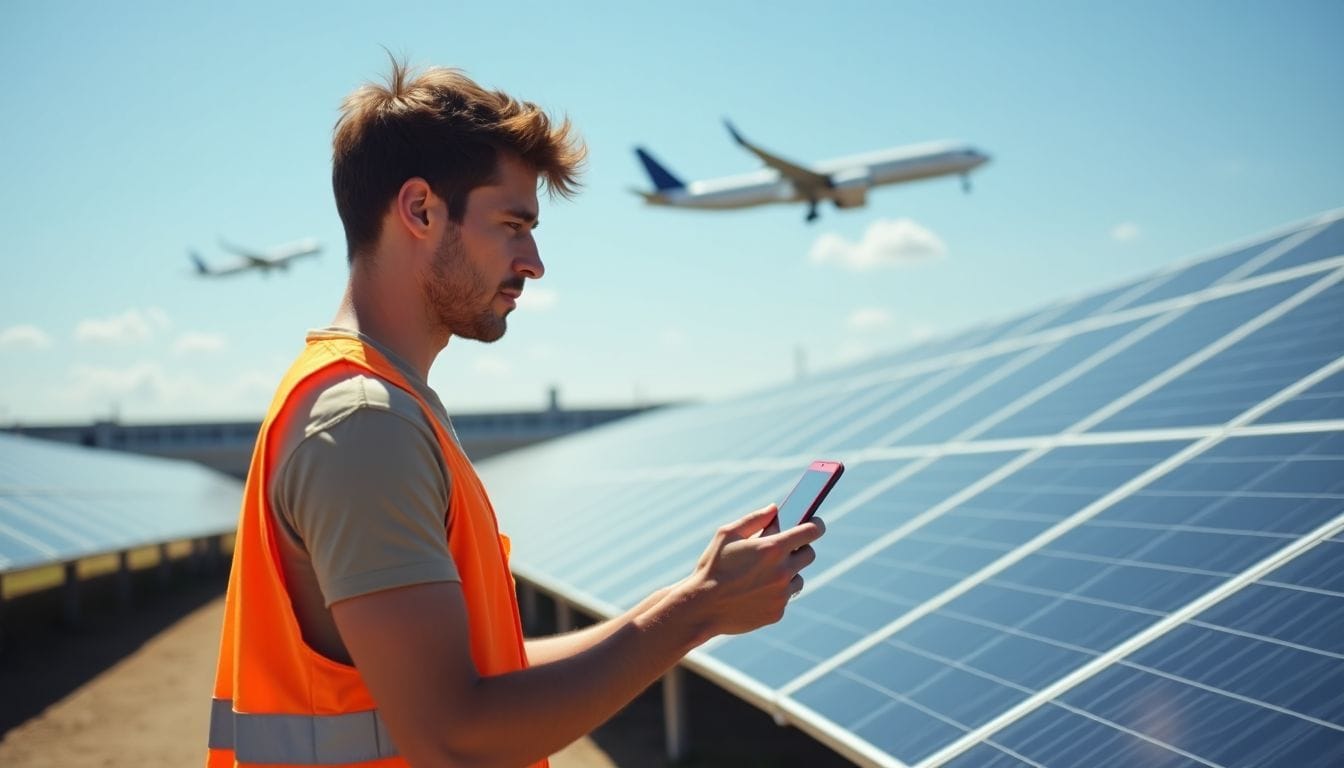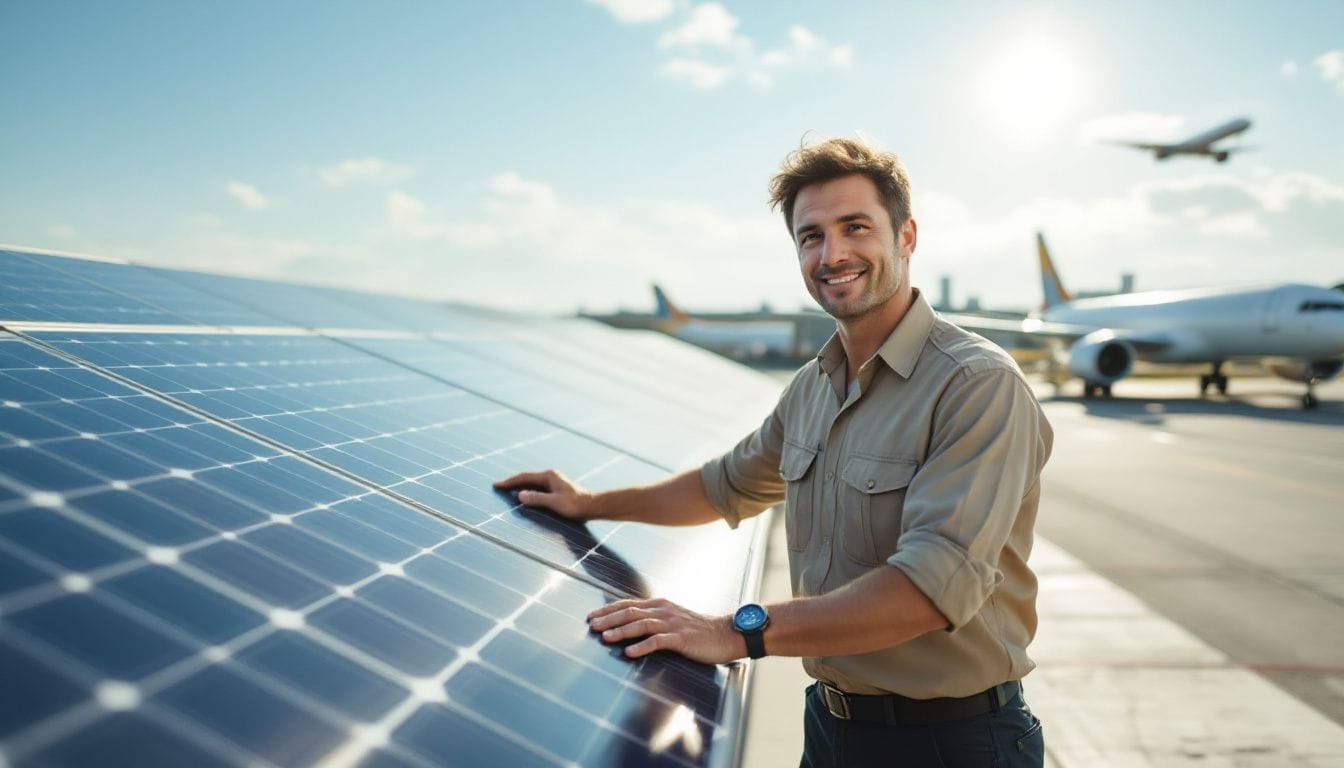Solar Panels For Airports
Airports use a lot of power. They need energy for lights, machines, and more. This can cost a lot and harm the earth. Solar panels for airports offer a fix. They can cut costs and help the planet.
Cochin Airport in India runs fully on solar power. It shows how airports can use clean energy. This guide will explain how solar panels work at airports. It will show why they’re good for air travel.
Read on to learn about this bright idea.
Key Takeaways
- Over 100 airports now use solar panels, with Cochin Airport in India being the first fully solar-powered airport in 2015.
- Solar panels at airports cut carbon emissions, reduce noise, and improve air quality for nearby communities.
- Airports can save lots of money with solar power, often cutting energy bills by half or more over time.
- Solar panels help airports become more energy independent and protect against power cuts and rising energy costs.
- Solar panels last 25-30 years with little upkeep, making them a smart long-term investment for airports.
The Rise of Solar Powered Airports

Solar-powered airports are taking off worldwide. Cochin International Airport in India led the charge in 2015. It became the first fully solar-powered airport with 46,000 panels generating 12 MW of power.
This sparked a global trend. Now, over 100 airports use solar panels for their operations and the wider power grid.
Airports are ideal spots for solar farms due to their vast open spaces. Chattanooga Metropolitan Airport in the USA meets all its power needs through solar. Denver International Airport plans to save $3 million over 25 years with its solar farms.
These projects cut costs and carbon footprints, making airports greener and more self-reliant.
Key Benefits of Solar Panels at Airports
Solar panels at airports offer big perks. They cut costs and boost green energy use.
Reduced Carbon Footprint
Airports can reduce their carbon footprint with solar panels. These panels generate clean energy without harmful gases. Cochin International Airport demonstrates this approach’s effectiveness.
It operates entirely on solar power and reduces 550 tonnes of CO2 annually.
Solar energy contributes to combating climate change. Airports account for 3.5% of global greenhouse gases. However, solar panels produce no CO2 during operation. This clean power can replace polluting fuels at airports, marking a significant step towards net zero goals.
Reduced emissions result in cleaner air near airports. Local communities benefit from decreased pollution. Solar panels also reduce noise. They operate quietly, unlike noisy fuel-based power plants.
This improves airports’ relationship with neighbouring areas.
Enhanced Energy Independence
Solar panels help airports become more energy independent. They make free power from sunlight, reducing the need for outside sources. This aids airports in running smoothly, even during power cuts.
It also guards them against rising energy costs.
Airports with solar power can meet their own energy needs. Some airports now get all their power from on-site solar farms. This self-reliance improves how they work and saves money over time.
It’s a clever choice for airports wanting to go green and cut costs.
Cost Savings in the Long Term
Airports can save loads of money with solar panels. Once set up, these panels make free power for years. This cuts energy bills by a lot. Many places offer cash help to put in solar, making it even cheaper.
As time goes on, solar costs less while old power gets pricier. This means more savings each year.
Panels last for 25-30 years with little upkeep. They work well in all weather at airports. Over time, the money saved on power bills pays for the panels and then some. Airports that use solar often see their costs drop by half or more.
This frees up cash for other important things.
Conclusion
Solar panels at airports cut costs and help the planet. They make flying greener and save money. Airports can lead the way in clean energy use. Commercial Solar UK offers top solar solutions for airports.
Start your airport’s solar journey today – it’s smart and simple.
FAQs
1. Why are airports good spots for solar panels?
Airports have lots of flat roofs and open space. This makes them ideal for solar arrays. They can use clean energy to run operations and cut greenhouse gases.
2. How do solar farms help airports go green?
Solar PV systems at aerodromes make clean power. This helps airports reach net-zero goals by 2050. It cuts the need for fossil fuels and boosts sustainability.
3. Are there risks with solar panels near runways?
Yes, glare from panels can affect pilots and air traffic control. But smart planning can fix this. Airports do glint and glare studies to place panels safely.
4. Which UK airport is leading in solar power use?
Bristol Airport is a top example. They’ve put in a 2.5 megawatt solar array. It can power the whole airport and save 2,000 tonnes of CO2 yearly.
5. How much power can airport solar farms make?
It varies, but some can produce over 10 megawatts. That’s enough to run airport ops and even sell extra power. It depends on the size and setup of the PV system.
6. What’s the future of solar power in aviation?
By 2025, more airports will use solar energy. They’ll add charging points for electric planes. This shift will help meet climate goals and cut carbon emissions in air travel.

